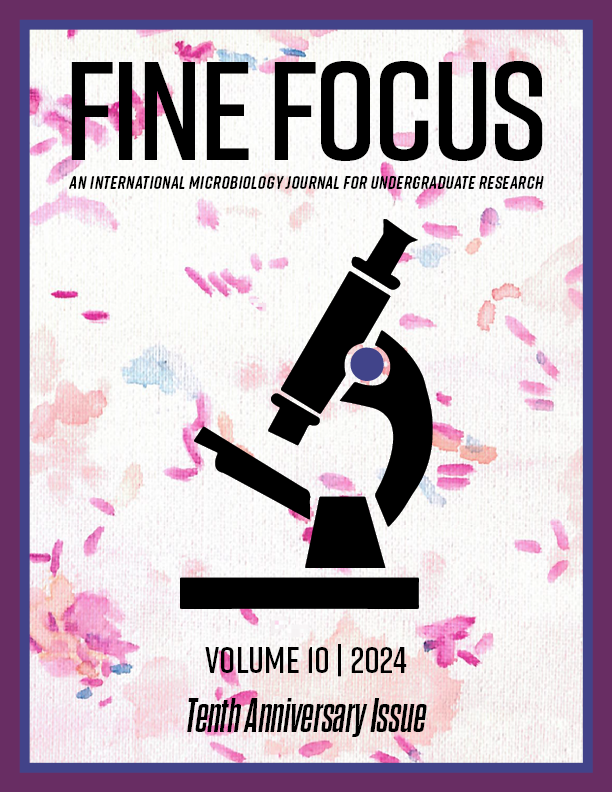Daily Case Trends of COVID-19
A Comparative Analysis of Indiana and Washington State
DOI:
https://doi.org/10.33043/FF.10.1.38-57Keywords:
COVID-19, Statistical analysis, indiana, public health, washingtonAbstract
The COVID-19 pandemic has caused immense and immeasurable disruption to billions of lives worldwide, and the strain on healthcare workers and facilities will undoubtedly be seen for years to come. Many factors impact the incidence and prevalence of COVID-19 in states, such as policies and legislation, funding, partisanship of the statehouse, vaccination rates, and rurality. The purpose of this paper is to analyze the differences in the daily positive cases between Indiana and Washington State and examine the respective ways each state tried to mitigate the morbidity and mortality of the virus. Indiana and Washington State were chosen as the states have similar populations in different geographical locations in the country and varying responses to the pandemic. Data was obtained from the respective state health departments over a period of two and a half years from March 2020 to December 2022. Independent t-tests were used for the analysis of the data between Indiana and Washington. Overall, Indiana had a higher daily positive case rate when compared to Washington. Indiana had a lower vaccination rate and had more hospitalizations and deaths compared to Washington and the US population as a whole. The difference in the findings of each state could be attributed to the partisanship of the state and the ways in which partisanship influences the enacting of legislation and policies intended to mitigate disease, as well as public health funding allocated by the state.
Downloads
References
Adolph, C., Amano, K., Bang-Jensen, B., Fullman, N., & Wilkerson, J. (2021, April 1). Pandemic Politics: Timing State Level Social Distancing Responses to COVID-19. Journal of Health Politics, Policy and Law, 45(6), 997-1015. doi: 10.1215/03616878-8802162.
Adolph, C., Amano, K., Bang-Jensen, B., Fullman, N., Magistro, B., Reinke G., & Wilkerson, J. (2020, August 31). Governor partisanship explains the adoption of statewide mandates to wear face coverings. MedRxiv, 1-33.
Andrews, N., Stowe, J., Kirsebom, F., Toffa, S., Rickeard, T., Gallagher, E., Gower, C., Kall, M., Groves, N., O’Connell, A., Simons, D., Blomquist, P. B., Zaidi, A., Nash, S., Aziz, N. I. B. A., Thelwall, S., Dabrera, G., Myers, R., Amirthalingam, G., Gharbia, S., Barrett, J. C., Elson, R., Ladhani, S. N., Ferguson, N., Zambon, M., Campbell, C. N. Brown, K., Hopkins, S., Chand, M., Ramsay, M., Bernal, J. L. (2021, December 14). Effectiveness of COVID-19 vaccines against the Omicron (B.1.1.529) variant of concern. medRxiv, 2021.2012.2014.21267615. https://doi.org/10.1101/2021.12.14.21267615
Ao, D., Lan, T., He, X., Liu, J., Chen, L., B, D. T., Z, K., & W, X. (2022, March 16). SARS-CoV-2 Omicron variant: Immune escape and vaccine development. MedComm., 3(1), e126. https://doi.org/10.1002/mco2.126
Baccini, L., Brodeur, A. (2020, December 1). Explaining Governors’ Response to the COVID-19 Pandemic in the Unites States. American Politics Research, 49(2), 215-220. doi: 10.1177/1532673X20973453.
Beland, L. & Oloomi, S. (2016, September 20). PARTY AFFILIATION AND PUBLICSPENDING: EVIDENCE FROM U.S. GOVERNORS. Economic Inquiry., 55(2), 982–995. https://doi.org/10.1111/ecin.12393
Burki, T. K. (2021, December 17). Omicron variant and booster COVID-19 vaccines. The Lancet Respiratory Medicine, 10(2). https://doi.org/10.1016/S2213-2600(21)00559-2
Capasso, A., Kim, S., Ali, A. H., Jones, A. M., DiClemente, R. J., & Tozan, Y. (2022, February 9). Socioeconomic predictors of COVID-19-related health disparities among United States workers: A structural equation modeling study. PLOS Global Public Health, 2(2). https://doi.org/10.1371/journal.pgph.0000117
Centers for Disease Control and Protection (2023, March 15). CDC Museum COVID-19 Timeline. David J. Spencer CDC Museum: In Association with the Smithsonian Institution.https://www.cdc.gov/museum/timeline/covid19.html#:~:text=January%2020%2C%202020,respond%20to%20the%20emerging%20outbreak.
Centers for Disease Control and Protection (2023). COVID-19 Vaccinations in the United States [Data Set]. CDC. https://covid.cdc.gov/covid-data-tracker/#vaccinations_vacc-people-fully-percent-total
Fan, Y., Li, X., Zhang, L., Wan, S., Zhang, L., & Zhou, F. (2022, April 28). SARS-CoV-2 Omicron variant: recent progress and future perspectives. Signal Transduction Target Therapy, 141. https://doi.org/10.1038/s41392-022-00997-x
Governor Jay Inslee. (2020, February 29). Inslee issues COVID-19 emergency proclamation. Retrieved April 5, 2023, from https://www.governor.wa.gov/news-media/inslee-issues-covid-19-emergency-proclamation
Guerra, F. M., Bolotin, S., Lim, G., Heffernan, J., Deeks, S. L., Li, Y., & Crowcroft, N. S. (2017, July 27). The basic reproduction number (R0) of measles: a systematic review. The Lancet. Infectious diseases, 17(12), e420–e428. https://doi.org/10.1016/S1473-3099(17)30307-9
Howard, J. (2022, February 11). While awaiting updated CDC guidance, here’s the data states are using to lift COVID-19 restrictions. CNN Health. https://www.cnn.com/2022/02/11/health/covid-metrics-states-lifting-restrictions/index.html
Huang, J., Fisher, B. T., Tam, V., Wang, Z., Song, L., Shi, J., Rochelle, C. L., Wang, X., Morris, J. S., Coffin, S. E., & Rubin, D. M. (2022, February 16). The Effectiveness of Government Masking Mandates On COVID-19 County-Level Case Incidence Across The United States, 2020. Health Affairs, 41(3). https://doi.org/10.1377/hlthaff.2021.01072
Indiana Department of Health. (2023). Indiana COVID-19 Home Dashboard. https://www.coronavirus.in.gov/indiana-covid-19-dashboard-and-map/
Indiana Department of Health. (2023). Indiana COVID-19 Vaccination Dashboard. https://www.coronavirus.in.gov/vaccine/vaccine-dashboard/
Johns Hopkins Coronavirus Resource Center. Coronavirus COVID-19 global cases by the Center for Systems Science and Engineering. https://coronavirus.jhu.edu/map.html. Published 2020. Accessed October 1, 2023.
Karki, J. E. & Benmir, M. (2022, June 17). Chapter 9 – Some key concepts of mathematical epidemiology. Mathematical Analysis of Infectious Disease., 137-162. https://doi.org/10.1016/B978-0-32-390504-6.00014-0
Kim, D., Shinde, S., Lone, S., Ramasubba R. P., & Ghodake, G. (2021, November 23). COVID-19 Pandemic: Public Health Risk Assessment and Risk Mitigation Strategies. Journal of Personalized Medicine. 11. 1243. 10.3390/jpm11121243.
King, C. (2021, March 18). Our year of COVID: Key dates in Indiana’s fight against the coronavirus. Indianapolis Star. https://www.indystar.com/in-depth/news/2021/03/18/indiana-covid-timeline-key-dates-states-fight-vs-pandemic/6813412002/
Kumar, A., Prasoon, P., Kumari, C., Pareek, V., Faiq, M. A., Narayan, R. K., Kulandhasamy, M., & Kant, K. (2020, October 21). SARS-CoV-2-specific virulence factors in COVID-19. Journal of Medical Virology, 93(3), 1195-1836. https://doi.org/10.1002/jmv.26615
Li, K., Jarvis, S., & Minhas, F. (2021, July 1). Elementary effects analysis of factors controlling COVID-19 infections in computational simulation reveals the importance of social distancing and mask usage. Computers in Biology and Medicine, 134 doi:https://doi.org/10.1016/j.compbiomed.2021.104369
Mitchell, A., Jurkowitz, M., Oliphant, J. B., & Shearer, E. (2020, June 29). Americans rate CDC highly, Trump and his administration poorly on getting the facts right about COVID-19. Pew Research Center. https://www.pewresearch.org/journalism/2020/06/29/americans-rate-cdc-highly-trump-and-his-administration-poorly-on-getting-the-facts-right-about-covid-19/
Neelon, B., Mutiso, F., Mueller, N. T., Pearce, J. L., & Benjamin-Neelon, S. E. (2021, January 6). Associations between governor political affiliation and COVID-19 cases, deaths, and testing in the United States. medRxiv. https://doi.org/10.1101/2020.10.08.20209619
Petersen, E., Koopmans, M., Go, U., Hamer, D. H., Petrosillo, N., Castelli, F., Storgaard, M., Khalili, S. A., & Simonsen, L. (2020, July 3). Comparing SARS-CoV-2 with SARS-CoV and influenza pandemics. Lancet Infectious Disease., 20(9), e238-e244. https://doi.org/10.1016/S1473-3099(20)30484-9
Pew Research Center. (2020, August 27). Mask use increased in summer months. https://www.pewresearch.org/short-reads/2020/08/27/more-americans-say-they-are-regularly-wearing-masks-in-stores-and-other-businesses/ft_2020-08-27_maskwearing_01a/
Prior, C. (2014, August). Rural Indiana: A Demographic and Economic Overview. Indiana State University Rural-Urban Entrepreneurship Development Institute. https://www2.indstate.edu/news/pdf/2014-08_IN%20Rural_Counties_Economic_Overview.pdf
Roozenbeek, J., Schneider, C. R., Dryhurst, S., Kerr, J., Freeman, A. L. J., Recchia, G., van der Bles, A. M., van der Linden, S. (2020, July 6). Susceptibility to misinformation about COVID-19 around the world. R. Soc. Open Sci. 7: 201199. http://dx.doi.org/10.1098/rsos.201199
State Health Compare. (2021). Per person state public health funding map. https://statehealthcompare.shadac.org/map/117/per-person-state-public-health-funding#a/37/154
Substance Abuse & Mental Health Services Administration. (2023, January 4). 2021 National Survery on Drug Use and Health. https://www.samhsa.gov/data/report/2021-nsduh-detailed-tables
Thomas, L. (2021, February 22). An overview of spike protein antigen COVID-19 vaccine candidates. Medical News. https://www.news-medical.net/news/20210222/An-overview-of-spike-protein-antigen-COVID-19-vaccine-candidates.aspx
Trust for America’s Health. (2022). State Profile: Indiana. https://www.tfah.org/state-details/indiana/
Trust for America’s Health. (2022). State Profile: Washington. https://www.tfah.org/state-details/washington/
US Census Bureau. (2020). QuickFacts Indiana. https://www.census.gov/quickfacts/IN
US Census Bureau. (2020). QuickFacts Washington. https://www.census.gov/quickfacts/WA
US Census Bureau. (2020). 2020 Census Results. https://www.census.gov/programs-surveys/decennial-census/decade/2020/2020-census-results.html
US Department of Agriculture. (2007, September 4). Washington – Rural Definitions: State-Level Maps. https://www.ers.usda.gov/webdocs/DataFiles/53180/25602_WA.pdf?v=0
US Department of Health & Human Services. (2020, June 25). Defining Rural Population. https://www.hhs.gov/guidance/document/defining-rural-population#:~:text=Office%20of%20Management%20and%20Budget%20Definition&text=A%20Metro%20area%20contains%20a,(MSA)%20are%20considered%20rural.
US News & World Report. (2023). Best States 2023. https://www.usnews.com/news/best-states
Vanderpool, R. C., Gaysynsky, A., & Chou, W. S. (2020, October 1). Using a Global Pandemic as a Teachable Moment to Promote Vaccine Literacy and Build Resilience to Misinformation. https://doi.org/10.2105/AJPH.2020.305906
Wang, H. (2022, April 16). Estimating excess mortality due to the COVID-19 pandemic: a systematic analysis of COVID-19-related mortality, 2020-21. The Lancet, 399: 1513-36. https://doi.org/10.1016/S0140-6736(21)02796-3
Washington State Department of Health. (2023). COVID-19 Dashboard. https://doh.wa.gov/data-and-statistical-reports/diseases-and-chronic-conditions/communicable-disease-surveillance-data/respiratory-illness-data-dashboard
Washington State Department of Health. (2023, March 3). Masking requirements in healthcare, long-term case, and correctional facilities to end April 3. https://doh.wa.gov/newsroom/masking-requirements-healthcare-long-term-care-and-correctional-facilities-end-april-3#:~:text=OLYMPIA%20%2D%2D%20Effective%20April%203,people%20age%205%20and%20older.
to Win. (2020). Indiana. https://www.270towin.com/states/Indiana
to Win. (2020). Washington. https://www.270towin.com/states/Washington
Downloads
Additional Files
Published
How to Cite
Issue
Section
License
Copyright (c) 2024 Lillia Marble

This work is licensed under a Creative Commons Attribution-NonCommercial-NoDerivatives 4.0 International License.
By submitting to Fine Focus, the author(s) agree to the terms of the Author Agreement. Beginning in Fall 2018, all authors retain copyrights associated with their article contributions and agree to make such contributions available under a Creative Commons Attribution-NonCommercial 4.0 International license upon publication in Fine Focus. Copyrights to articles published prior to Fall 2018 have been transferred from the authors to Fine Focus.



